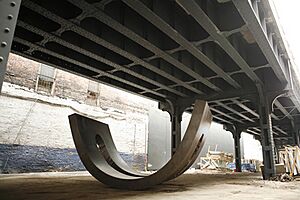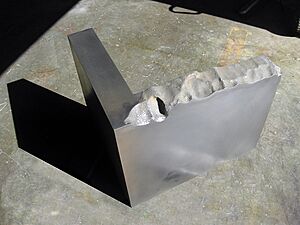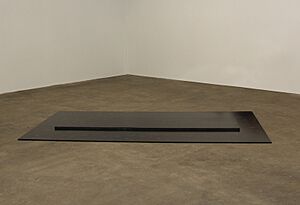Christine Corday facts for kids
Christine Corday, born in 1970 in Fort Meade, Maryland, is an American artist. She creates amazing paintings and huge sculptures. Her art often explores ideas from science, like astronomy and chemistry. Christine Corday wants people to touch her sculptures. This way, the art changes over time as people interact with it. Her artworks are found in private collections around the world, including Paris, Tokyo, and New York City. Her first big solo show, called PROTOIST SERIES: SELECTED FORMS, was at the Los Angeles County Museum of Art.
Contents
Early Life and Learning
Christine Corday grew up in Maryland. She loved both art and science from a young age. She learned to play the piano classically. In 1991, she wrote a research paper that led to an internship at NASA Ames Research Center. She studied astrophysics there.
She earned her Bachelor's degree in Communication Arts in 1992. Later, she took graduate classes in cultural anthropology at Washington University. From 1992 to 1999, she worked as a designer for advertising companies. These included famous ones like Wieden+Kennedy.
Around 1999 and 2000, Corday started focusing on painting. She lived in Tokyo, Japan, for a year. Then she moved to Seville, Spain, for three years. There, she worked on a project about sound and ocean energy. She called it "Instrument for the Ocean to Play."
Her time in Spain changed her art. She started using only black paint. She even made her own tar-like paint from natural materials. These black paintings were like early ideas for her large sculptures.
Art Career
From 1992 to 1999, Christine Corday worked as a graphic and structural designer. She worked for companies all over the world.
The PROTOIST Series
Corday's first big steel sculpture is called UNE. It weighs three tons! This artwork started her PROTOIST SERIES. "PROTOIST" is a word she made up. It describes the space between what we know and what we don't know.
UNE is made from raw weathering steel. It stands almost 9 feet tall. It has a thick arc that spans over 16 feet. A large hole, about 2.5 feet wide, goes through the middle. This hole was cut with a torch.
UNE began its journey in Chelsea, New York, under the High Line. This was in late 2008. The sculpture was so inspiring that local construction workers made a small steel copy for her.
The PROTOIST SERIES is designed for people to touch. The idea is that human interaction will slowly wear down the sculptures. This leaves a mark of everyone who has experienced them. Each piece is meant to be touched, walked on, or even entered. These artworks are often placed in unexpected spots. This could be an old building, a city alley, or a public square. The goal is to create surprising encounters with art.
AHN is another sculpture in the PROTOIST SERIES. It was placed in a large art space in Brooklyn, New York. This 300-pound steel piece makes you think about choices. It shows how different parts of reality come together. One art reviewer said AHN has a "grounding resonance."
In 2011, a smaller model of another PROTOIST sculpture, ÆPI, was shown. This was at an exhibition in New York City. The name ÆPI combines the Greek word "epi" (meaning "upon") with a lost Latin sound. The sculpture has a torch-cut center plate. Standing on this plate changes your perception by a small amount. It makes your senses sharper. It's like a quiet "big bang" that invites you to see what's unseen.
Corday's art is in private collections in many cities. These include Dubai, Dublin, Mexico City, and Paris.
Her current projects include a permanent art series called HELDAN. She is also working on a huge outdoor sculpture. It's called INSTRUMENT FOR THE OCEAN TO PLAY. This artwork uses tidal power to make a low-frequency sound.
Painting Works
In 2000, Corday moved her art studio from Tokyo, Japan, to Seville, Spain. During her years in Spain (2000–2004), she mostly used black paint. She made her own tar-like paint. She mixed raw pigments and charcoal into a special base. She also made her own tools to apply this paint to raw linen and canvas.
In 2005, Corday moved back to the United States. She set up a studio in Greenpoint, Brooklyn, New York. Here, she created a series of paintings. These were like abstract plans for her sculptures, HELDAN and the PROTOIST Series.
In 2009, a painting called THAHLES was bought by the Richard Meier collection. It is a very large painting, measuring 72 by 216 inches. In 2013, another painting, PROME, was acquired by the San Francisco office of Skidmore, Owings & Merrill.
National September 11 Memorial
Christine Corday played an important role in the National September 11 Memorial. This memorial honors the victims of the September 11 attacks and the 1993 World Trade Center bombing.
The memorial's architect, Michael Arad, chose Corday's special black finish. This finish was used for the bronze panels around the waterfall pools. These panels have the names of all 2,983 victims. The pools are located where the Twin Towers once stood.
A company called KC Fabrications helped choose the bronze finish. They were impressed by Corday's work. Corday said about the project, "Every name has run under the palm of my hand." She added, "Each name here is a life, and that's never been lost on anyone that's worked on this project."
ITER and the Sans Titre Project
For the past three decades, 35 countries have worked together. Their goal is to build a sun on Earth. This amazing project is called ITER. It is located in Saint-Paul-lès-Durance, France. ITER is dedicated to studying how stars create energy. They are trying to create a star-like power source for humans.
Christine Corday worked with ITER Directors for five years. As a result, art became the 36th and final global contributor to the project. A single artwork was placed inside the star's structure. This untitled artwork, Sans Titre (which means "Untitled" in French), weighs two pounds. It is now part of ITER's M30 Bolts. These bolts are crucial for holding together the huge parts of the Tokamak. The Tokamak is the heart of the star-making machine.
Corday explained her artwork: "We are the generation witnessing a star being built on Earth. As a sculptor, my tools are like the hammer and chisel of the universe. My materials come from suns." She felt it was important for a single artwork, made from star metals, to support this science project.
ITER is an international effort to build a nuclear fusion reactor. The goal is to see if nuclear fusion can be a future energy source. This is the same process that powers stars. This idea fascinated Christine Corday. She said she was "wholly magnetized" when she learned about the project.
ITER achieved its "first plasma" in 2025. Sans Titre will quietly observe this important moment. ITER Director-General Bernard Bigot said the bolt "will be looking down into the fusion process." It will be a direct witness to the first burning plasma.
Laban Coblentz, ITER's Communication Head, noted that Sans Titre shows art supporting "science's greatest achievement." Art is not just decoration here. It is a lasting and contributing presence.
On July 28, 2020, French President Emmanuel Macron hosted world leaders. They celebrated the start of the ITER Tokamak assembly.
Awards and Recognition
Christine Corday has received many awards. In 2019, she won a National Endowment for the Arts grant. This was for her solo exhibition, Relative Points, at the Contemporary Art Museum St. Louis. She also received the 2019 Pollock-Krasner Foundation Brian Wall Foundation grant for sculptors.
In 2016, she was nominated for a United States Artists fellowship. Corday also won the Edison Ingenuity Prize in Montreal, Canada. She has won international design awards for her special glass bottle for The Republic of Tea. In 2000, she won a short story prize from Francis Ford Coppola's magazine, Zoetrope.
About Her Life
Between 1996 and 2005, Christine Corday lived and worked in several cities. These included Portland, Oregon; San Francisco, and Los Angeles, California; Tokyo, Japan; and Seville, Spain. During this time, her art focused on fine arts. She especially worked on sculpture and architecture.
Christine Corday now lives in New York.




